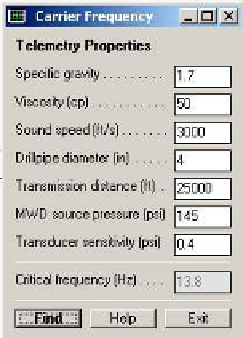Geology Reference
In-Depth Information
e.g., small rotor-housing clearances, reduced rotor-stator gap distances, good
rotor-stator azimuthal overlap, or possibly, all of the foregoing.
Just how optimally can a new high-data-rate mud pulse MWD system
perform? And how would this compare with the best systems currently
available? To answer these questions, we first describe calculated results used
to validate our formula for critical frequency. Figure 10.7 shows the software
interface developed to host the calculation. Here, the input values P
0
(145 psi),
P
xdcr
(0.4 psi), specific gravity (1.7, for 14 lb/gal mud) and viscosity (50 cp) are
taken from Hutin, Tennent and Kashikar (2001) in “New Mud Pulse Telemetry
Techniques for Deepwater Applications and Improved Real-Time Data
Capabilities.” The pipe diameter (4.0 in), depth (25,000 ft) and sound speed
(3,000 ft/s) are our estimates. These assumptions, for our Run A, give a critical
frequency of 13.8 Hz, which would be consistent with the 12 Hz siren carrier
frequency used by Schlumberger at such depths to achieve 3 bps. In this
respect, the model for critical MWD carrier frequency provides reasonable
results, which have been further supported by sensitivity analyses.
Figure 10.7.
Critical frequency calculation.
In Run B, we repeat Run A except that the transmission depth is increased
to 35,000 ft. The result demonstrates that the critical frequency is reduced to
f
crit
= 7.0 Hz so that the 3 bps obtainable at 12 Hz is no longer possible - it is known
that the company instead transmits at approximately 1 bps. Again, our model
conclusions are reasonable.
We use this model to evaluate other published data. Only limited
information on BakerHughes's system is available, e.g., “15 bps in the North
Sea to a depth of 24,000 ft,” “20 bps at depths less than 6,000 m, and just over 3
bps from depths of more than 10,000 m,” and “rates of 30 bps have been
achieved from 3,000 m onshore and 40 bps from 900 m in a test well.”
Corresponding mud properties and pipe diameter data are not published, so that

Search WWH ::

Custom Search